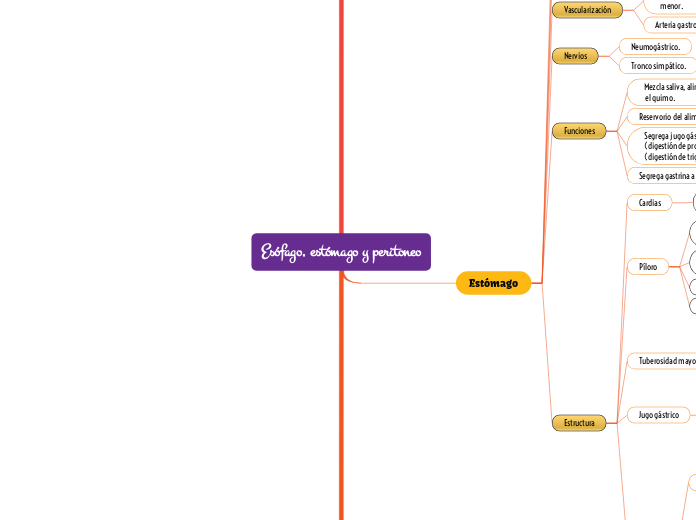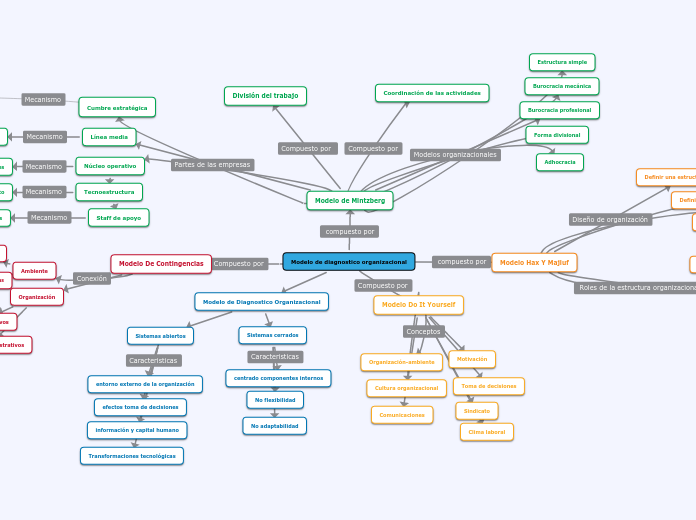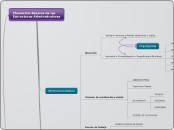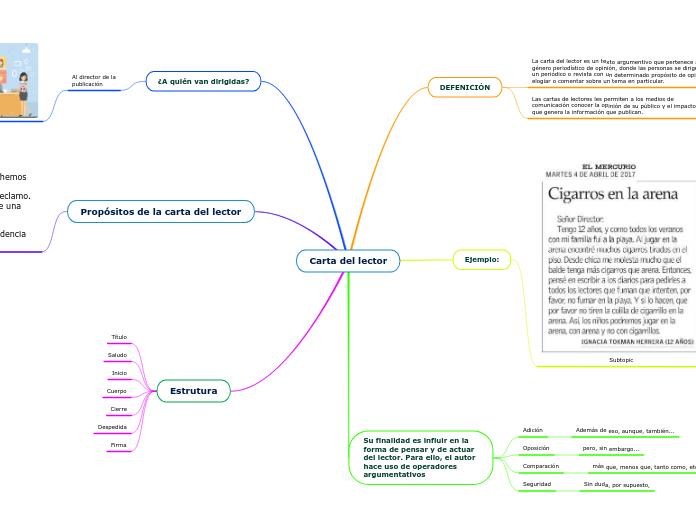Esófago, estómago y peritoneo
To name your story, you have to think about the overall message and what you want your audience to understand from the story. Also, make it relevant and easy to remember.
Peritoneo
The ending of a story is essential. We all know that if the ending is weak, what happened before loses its importance. So make it unpredictable, but fair. A resolved ending answers all the questions and ties up any loose threads from the plot.
Transcavidad de epiplones
This is the closure section of the story.
See examples of possible outcomes below:
- all problems have been solved
- it's clear how each one of your characters ends up
- your main character is transformed by the challenge
Mesenterio
Permite movilidad de las asas y las sujeta.
Aspecto de abanico, une el intestino delgado a la pared abdominal posterior.
Epiplón mayor
Defiende a los órganos de infecciones.(policía del abdomen).
2 capas.
La hoja más grande del peritoneo, cae sobre el colon transverso y cubre el intestino delgado como un delantal adiposo.
Ligamento gastrocólico.
Epiplón menor
Try answering these questions in order for you to come up with a closure:
- Have all problems been solved?
- Is it clear what happens with all your characters in the story?
- Has the challenged transformed your main character?
- How do the characters feel in the end?
Contiene algunos ganglios linfáticos.
Se extiende hasta el hígado.
Surge como dos hojas de la serosa del estómago
y el duodeno.
Se comunica con cavidad abdominal mayor con el orificio epiploico o Hiato de Winslow.
Try answering these questions to come up with a closure:
- Have all the problems been solved?
- Is there a clear picture of what happens with each character in the story?
- Has the challenge transformed your main character?
- How do the characters feel in the end?
Algunos órganos se localizan en la pared abdominal posterior, estos órganos, incluyendo los riñones y el páncreas, se denominan retroperitoneales.
This is the moment when the main character surpasses the last obstacle and finally faces their greatest challenge.
The climax usually follows one of these patterns:
- realization
- resolution
- choice
Type in your answer.
Parietal
Reviste la pared de la cavidad abdominopelviana.
Cavidad peritoneal
Espacio entre ambos con líquido seroso.
Visceral
Cubre órganos abdominales.
Membrana serosa más grande del cuerpo
Externamente cubre a las vísceras abdominales.
Recubre internamente cavidad abdominal y pélvica.
Estómago
The middle of the story is where you add layers of complications that will lead to the end. Reveal more about the character's journey. Did their personality go through changes? How did they overcome the challenges? And as you build up the story’s central conflict, make it more personal to that character. Also, from the middle act, you have to lead into the final act.
Serosa
Protege músculos.
3 Capas de músculo liso:
Oblicua interna.
Circular media.
Longitudinal externa.
Vasos sanguíneos y nervios.
Tejido conectivo aerolar.
3 Células secretoras:
Parietales
3 Receptores para:
Histamina: H1, H2.
Gastrina.
Acetilcolina.
Producen factor intrínseco(absorción de vitamina B12) y ácido clorhídrico.
Cimógenas
Elabora pepsinógeno y lipasa gástrica.
Jugo gástrico
Moco, pepsinógeno, factor intrínseco y ácido clorhídrico.
Tuberosidad mayor(fundus)
Antro pilórico
Entre el cuerpo y el píloro.
Por debajo del fundus, se extiende la porción central del estómago, llamado cuerpo..
Se une al bazo por el epiplón gastro esplénico.
Dilatación en parte superior, cámara de aire, color negro.
Píloro
Borde externo y convexo.
Curvatura mayor
Borde interno cóncavo del estómago.
Curvatura menor
Fibras circulares del músculo que abren y cierran el orificio pilórico.
A través del esfínter pilórico comunica el estómago con el duodeno.
Cardias
Comunica al esófago con el estómago. Se abre y se cierra.
Funciones
Segrega gastrina a la circulación sanguínea.
Segrega jugo gástrico (es bactericida y desnaturaliza las proteínas), pepsina (digestión de proteínas), factor intrínseco (absorción de B12) y lipasa gástrica (digestión de triglicéridos).
Reservorio del alimento antes de ir al intestino delgado.
Mezcla saliva, alimento y jugo gástrico para formar
el quimo.
Nervios
Tronco simpático.
Neumogástrico.
Vascularización
Arteria gastroepiploicas (curvatura mayor).
Arteria coronaria etomáquica y hepática(curvatura menor.
Capacidad de 1,5 L.
There wouldn't be any tension and excitement in your story if there weren't any obstacles in your character's way.
25 cm.(longitud) / 12cm(ancho) / 8cm(profundidad).
Your character(s) need(s) motivation in order to solve the challenge(s).
Órgano torácico abdominal
Each story has a main character and that character usually needs to solve a problem or challenge. The character's challenge is the one that creates tension throughout the story.
Se interpone entre el esófago y el duodeno.
En hipocondrio izq. y epigastrio.
In most stories, there are 3 challenges. The number 3 is a mystical number symbolizing completeness. Try to come up with interesting challenges with which your character needs to struggle.
See a few examples below:
- turns into a werewolf at night
- is sent back in time
Esófago
In the beginning of the story (or the exposition), you will need to introduce the setting and characters. You might also want to introduce the main conflict. This part of the story is important because it gives the reader necessary background information and maybe even a first insight into a character’s personality.
Nervios:
Ramas del neumogástrico.
Vascularización:
Arterias tiroidea inf., bronquiales y ramas de la aorta.
Estructura
The setting (time & place) of a story can change throughout the plot.
Capas
The weather is an important element in your story because it can highly influence the ambiance and the mood of the characters.
Adventicia
Más externa, no tiene aún una membrana serosa.
Muscular
The most affected character is the main character. Write down here if he/she is affected by these weather conditions in any way. For example, if they lost a family member or their home during a hurricane, etc.
Forma dos esfínteres
El esfínter esofágico inferior: Formado por músculo liso.
Regula progresión del alimento desde el esófago hacia el estómago.
El esfínter esofágico superior : Formado por músculo esquelético.
Regula la progresión del alimento desde la faringe hacia el esófago.
Tercio inferior: Músculo liso.
Tercio intermedio: Músculo esquelético y músculo liso.
Región superior de esófago :músculo esquelético.
Submucosa
Decide if you want to include an element of nature in your story. For example, a rainbow can be a very nice choice for a happy ending. The mist in a story can represent mystery and secrets. A thunder can appear in the background at the moment when the 'bad guy' of the story makes its appearance, etc.
tejido conectivo areolar, vasos sanguíneos y glándulas mucosas.
Mucosa
Does your story include catastrophic weather? See a few suggestions below or add your own:
- hurricane, earthquake, storm, etc
Lámina propia (tejido conectivo areolar) y
la muscularis mucosae (músculo liso).
Blanca, gruesa, epitelio escamoso, posee glándulas.
3 Estrechamientos
Your story can take place wherever your imagination will take you to.
For example: in an elevator, in an enchanted forest, etc. Don't forget to give details of the environment each time the setting changes, otherwise, the story can be confusing. Also, mention the seasons as each of them has unique weather and events.
Diafragmático.
Aórtico bronquial.
Cricoideo.
Se relaciona:
Arriba con faringe(en cartílago cricoides), abajo con estómago(en cardias), adelante con tráquea.
Aplanado (vacío)/Tubular (lleno).
25cm(longitud) y 5-15mm (diámetro).
Secreta moco y transporta alimentos hacia el estómago.
Detrás de la tráquea:
Characters are essential to a good story. Usually, the protagonist(s) is/are the most affected by the plot. Introduce a character by focusing on their actions, interests, and occupation, as the physical appearance doesn't make a difference in most cases.
Pasa a través del diafragma, por el hiato esofágico, y termina en la porción superior del estómago.
Type in the name of your character.










